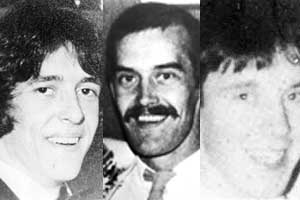29 November 2007 Edition
Summary execution documents must

Gerard Casey, Daniel Doherty and Francis Bradley
By Laura FrielDOCUMENTS relating to the summary executions of three men must be surrendered to the coroner in the event of new inquests, a Belfast judge ruled this week.
The documents relate to the killing of two men in shoot-to-kill operations by the British SAS – Danny Doherty in 1984 and Francis Bradley in 1986 – and a third collusion victim, Gerard Casey, shot dead by a British military-inspired death squad in 1989.
New documents relating to the killings came to light following a trawl through RUC papers after a recent judgement by the British House of Lords. The law lords ruled that the police are obliged to give the coroner all the documents in their possession.
Following the judgement, the families of the victims applied to the Belfast High Court for orders compelling the current PSNI Chief Constable, Hugh Orde, to produce the documents.
At the High Court, presiding Judge Weatherup decided that, during inquests into the men’s deaths (held more than 20 years ago), the RUC had failed to furnish all the available information to the coroner’s court.
During the hearing, Weatherup was informed that the Attorney General had been already asked to hold a new inquest into the killing of Danny Doherty.
“If the Attorney General directs a coroner to conduct a new inquest the police will be obliged to furnish all the information in the possession of the police concerning the findings of the body or the death,” said the judge.
“The new coroner will determine the extent of disclosure of documents to the family of the deceased and will determine issues of relevance, privilege and public interest immunity,” said Weatherup.
Daniel Doherty was one of two IRA Volunteers killed in an SAS ambush in the grounds of Gransha Hospital in Derry. Although armed with two handguns, neither Volunteer opened fire when the motorcycle on which they were travelling was rammed by a British undercover unit. Fifty-nine shots were fired by a British Army squad which included members of the 14th Intelligence as well as the SAS.
Forensic evidence submitted during the inquest suggested one Volunteer had been knocked off the bike as it was rammed and that the motorbike continued out of control for a short distance with both men having already been hit by gunfire.
According to medical evidence, six shots were fired into Danny Doherty as he lay on the ground. In classic SAS shoot-to-kill tactics, both victims were shot in the head. None of those responsible for the killings appeared at the inquest. Instead, prepared statements were read to the court by a member of the RUC.
The SAS attempted to characterise the incident as an unplanned response to ‘two men on a motorbike, acting suspiciously’ rather than a planned shoot-to-kill operation. In a statement, a soldier claimed that when he approached, the passenger raised a gun and the motorbike accelerated towards him. Both victims were repeatedly shot in the back.
The jury at the inquest found the men should have been arrested rather than shot. Information that there are documents relating to the killing which have not been disclosed prompted the Doherty family to ask for a new inquest.
Twenty-year-old Francis Bradley was shot dead by an undercover SAS squad in February 1986. At the time, the British Army and the RUC claimed Bradley had been armed, in the company of other armed men and moving weapons from a dump for the IRA.
In fact, Bradley had not been armed, was alone at the time of the shooting and he was not moving weapons from a dump. In other words, Bradley posed no possible threat whatsoever when he was shot in the back and head at close range by an undercover British soldier.
In what became a recognisable death squad execution in the style of the British Army covert Force Research Unit, Gerard Casey was shot dead when two masked men, dressed in green British Army-type jackets, smashed their way into his home. The gunmen open fire at close range, killing Gerard as he lay in bed with his wife. The killing was later claimed by the UDA.
Gerard was an IRA Volunteer but not known as a republican at the time. Prior to the killing, a legally-held shotgun was removed from the Casey home and a sketch map of the interior drawn by the RUC.
A few months before his death, Gerard had been arrested and taken to Castlereagh Interrogation Centre. During his interrogation, the RUC threatened to assassinate Casey and said the killing would be claimed by loyalist paramilitaries.


